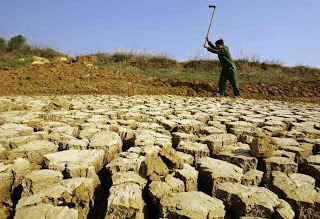To give you an idea of scale: a 4°C rise in global temperatures (by itself) equals 39.2°F.
°C * (9/5) + 32 = °F
25°C * (9/5) + 32 = 77°F
26°C * (9/5) + 32 = 78.8°F
27°C * (9/5) + 32 = 80.6°F
28°C * (9/5) + 32 = 82.4°F
29°C * (9/5) + 32 = 84.2°F
25°C equals 77°F (room temperature), so an increase of 4°C is 84.2°F (sweat, fans and AC).
Over the years at the U.N. climate talks, the goal has been to keep future global warming below 2°C. But as those talks have faltered, emissions have kept rising, and that 2°C goal is now looking increasingly out of reach. Lately, the conversation has shifted toward how to deal with 3°C of warming. Or 4°C. Or potentially more.
 |
| Drought in Yunnan Province, China |
And that topic has made a lot of people awfully nervous. Case in point: The World Bank just commissioned an analysis (pdf) by scientists at the Potsdam Institute looking at the consequences of a 4°C rise in global temperatures above pre-industrial levels by 2100. And the report appears to have unnerved many bank officials. “The latest predictions on climate change should shock us into action,” wrote World Bank President Jim Yong Kim in an op-ed after the report was released Monday.
So what exactly has got the World Bank so worried? Partly it’s the prospect that a 4°C world could prove difficult—perhaps impossible—for many poorer countries to adapt to.
Washington Post:
Comments